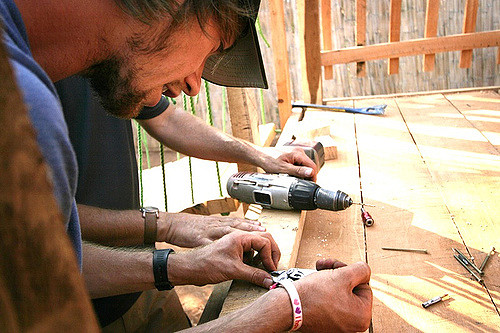Unlock the Magic in Your Story Now
Get the Free 20 questions to Ask Before Launching Your Idea workbook when you sign up for occasional updates.
Get the Free 20 questions to Ask Before Launching Your Idea workbook when you sign up for occasional updates.
Two Essential Characteristics Of Story-Driven Brands
filed in Storytelling, Strategy
 You’ve probably had a disappointing experience with a brand or business. Maybe you couldn’t put your finger on what was wrong or why? Customer dissatisfaction is a result of a gap between promises and actions. Filthy bathrooms at the restaurant with the elaborately embossed menu. The snappy flight attendant who wears a painted on smile. Uncomfortable plastic seats in the chiropractor’s waiting room. Out of date produce on sale in the organic grocery store. A damaged delivery that was carelessly packaged.
You’ve probably had a disappointing experience with a brand or business. Maybe you couldn’t put your finger on what was wrong or why? Customer dissatisfaction is a result of a gap between promises and actions. Filthy bathrooms at the restaurant with the elaborately embossed menu. The snappy flight attendant who wears a painted on smile. Uncomfortable plastic seats in the chiropractor’s waiting room. Out of date produce on sale in the organic grocery store. A damaged delivery that was carelessly packaged.
People often ask me about the secret of a great brand story. I think there are two. Truth and consistency. It’s hard to live one without the other. When our brands are story-driven, that story is lived in every single decision, consistently, on good days and bad. The delight is in the detail.
Image by Dukas Ju.
Share this article
Difference By Design
 Yesterday I was registering a domain name online when I noticed the company had tweaked the user interface from cart to checkout. Now when you confirm the purchase, the default option is to register for three years, instead of one. The steps to reverse this are not obvious or easy—which I guess means sales are up by 66%—especially with new or inexperienced customers.
Yesterday I was registering a domain name online when I noticed the company had tweaked the user interface from cart to checkout. Now when you confirm the purchase, the default option is to register for three years, instead of one. The steps to reverse this are not obvious or easy—which I guess means sales are up by 66%—especially with new or inexperienced customers.
I’m left trying to imagine the meeting where the head of the business development thought this was an excellent growth strategy and a software engineer implemented the change against her better judgement. Would they consider it acceptable if a sales assistant at a bricks and mortar store tripled their father’s bill by adding two additional items to his basket without permission—just because they could?
The data is clearly telling the company they’re winning, but at what cost? We make a difference by design, not by default—when we put our hand on our heart and question whether this is the right thing to do.
*Note: Since I (and no doubt other customers) drew this to the company’s attention they have rectified the situation. They also denied ever having defaults for domain registrations unless required by the Registry, because this would prohibit them from functioning as a Registrar. Again this goes back to the earlier point. Integrity doesn’t require rules.
Image by David Joyce.
Share this article
The Easy Part Of Marketing
 The easy part of marketing is working out what to say, when and where, to whom, in order to sell what we make. We expend most of our energy on the easy part.
The easy part of marketing is working out what to say, when and where, to whom, in order to sell what we make. We expend most of our energy on the easy part.
The hard part is understanding why it’s important to say what we’re about to say and who will care enough to listen. We should start with the hard part.
Image by sharkhats.
Share this article
The Secret To Being Exceptional
filed in Storytelling, Success
 You might remember when you were a high school student (as I do) trying to work out a revision system that helped you to maximise your chances of academic success. I never had much luck. Teachers held up model students as examples of how ‘hard work’ paid off. Straight-A students it seemed were the ones who did ‘the most’ work. And ‘most’, being infinite was a daunting place to start.
You might remember when you were a high school student (as I do) trying to work out a revision system that helped you to maximise your chances of academic success. I never had much luck. Teachers held up model students as examples of how ‘hard work’ paid off. Straight-A students it seemed were the ones who did ‘the most’ work. And ‘most’, being infinite was a daunting place to start.
It’s taken me a good thirty years to realise that exceptional performance is not a result of expending the most effort—trying to reach the summit in a single, spectacular leap. The secret to being exceptional is in the small choices we make moment-to-moment. The student who organises his notes from the very first lecture of the first semester. The hotel receptionist who consciously makes every interaction meaningful. The athlete who pushes through the last three uncomfortable reps. The CEO who intentionally seeks out and acts on the wisdom of his team. The doctor who greets her patients warmly by shaking them by the hand. Ordinary people making small choices that incrementally make them exceptional.
Small, deliberate choices, made moment-to-moment, have a huge impact over time—not just on the work we do and the people we serve, but on our belief about what’s possible. It’s easy to fall into the trap of complaining about the things beyond our control we can’t change. If we want to be exceptional, we need to get into the habit of finding reasons why we must, instead of making excuses why we can’t.
Image by Louis Vest.
Share this article
The Power Of Expectations
filed in Marketing, Storytelling
 The packaging on the flat-pack garden shed promised fast, easy assembly (80% faster than the competitor’s product), using 75% fewer screws, pre-drilled holes and a 30-year warranty. Taking the manufacturer at their word the customer’s expectation is set. The shed takes two people five hours to assemble, requires additional drilling, a trip to the hardware store to buy a special riveting tool and leaves the weary handymen with a bag of fifty extra screws and abandoned Sunday afternoon plans. There’s a clear mismatch between the expectation the company set and the reality the customer experienced.
The packaging on the flat-pack garden shed promised fast, easy assembly (80% faster than the competitor’s product), using 75% fewer screws, pre-drilled holes and a 30-year warranty. Taking the manufacturer at their word the customer’s expectation is set. The shed takes two people five hours to assemble, requires additional drilling, a trip to the hardware store to buy a special riveting tool and leaves the weary handymen with a bag of fifty extra screws and abandoned Sunday afternoon plans. There’s a clear mismatch between the expectation the company set and the reality the customer experienced.
Dissatisfied customers are not just created by products and services that don’t work. Dissatisfaction is also a direct result of the stories we the marketers lead customers to believe. Expectations once set are hard to shift. Our words have the power to change so much more than the customer’s decision to click the buy button. We should use them wisely.
Image by Melody Hansen.
Share this article
Less But Better
 In the bygone era of local shopping strips lined with family owned businesses the job of each business wasn’t simply to make a profit—it was to add value to the community it served. Every business had a purpose beyond the single bottom line. Every transaction, from a pint of milk to five screws wrapped tightly in brown paper, mattered. Paradoxically it was the care the owners took with the smallest order that helped them to thrive for longer than the big chain stores might have predicted.
In the bygone era of local shopping strips lined with family owned businesses the job of each business wasn’t simply to make a profit—it was to add value to the community it served. Every business had a purpose beyond the single bottom line. Every transaction, from a pint of milk to five screws wrapped tightly in brown paper, mattered. Paradoxically it was the care the owners took with the smallest order that helped them to thrive for longer than the big chain stores might have predicted.
We’ve come to believe that people always want more or that they invariably choose the fast and easy option. This isn’t true of every customer. What if instead of trying to deliver more, faster to everyone we strived to do less but better for fewer?
Image by John Weiss.
Share this article
The Simple (Not Easy) Strategy For Business Growth
 When we think about business development opportunities, we mostly begin by knowing exactly where we are today and what goals we want to reach next. From there we set out to widen our net and acquire more customers or users for our existing products and services. Our growth strategy starts with the need to expand our customer base in pursuit of the targets we set.
When we think about business development opportunities, we mostly begin by knowing exactly where we are today and what goals we want to reach next. From there we set out to widen our net and acquire more customers or users for our existing products and services. Our growth strategy starts with the need to expand our customer base in pursuit of the targets we set.
If Steve Jobs had stuck with only this kind growth strategy, the iPhone wouldn’t exist. What he did instead of simply casting the net wider was connect the dots between Apple’s capabilities and where the customer would want to go next—even before the customer knew himself.
Net widening is a fine growth strategy, but it’s also one your competitors are likely adopting—which means whoever gets new customers faster (perhaps by being cheaper) will come out on top. There is an alternative.
We can create long-term value for our companies by understanding where the customer is today and where they want to go next. The path to growth doesn’t always mean having a bigger net. Often it’s about taking the time to consider if a net is the best tool for the job.
Image by Hasin Hayder.
Share this article
More Vs. Deeper
 On the surface of it, the all-you-can-eat buffet seems like a generous bargain. Why is it then that we walk away having had our fill without feeling satisfied? The truth is we know that far from being generous the offer of ‘more’ is a tactic to get the most people through the door. We understand the restaurant owner is hoping we come with small appetites and leave early.
On the surface of it, the all-you-can-eat buffet seems like a generous bargain. Why is it then that we walk away having had our fill without feeling satisfied? The truth is we know that far from being generous the offer of ‘more’ is a tactic to get the most people through the door. We understand the restaurant owner is hoping we come with small appetites and leave early.
Contrast the all-you-can-eat experience with that of the performer who must somehow find a way to deliver value to a stadium of 75,000 fans, most of whom she can’t reach or look in the eye. Singing one more song at the end of her set is unlikely to create the connection she hopes to make with each person. Her only option is to find ways to go deeper.
So she shares intimate stories of her journey from support act to superstar. She acknowledges the unique attributes of the city she’s performing in. She displays unpublished images from her childhood on the big screen. And she makes tiny handwritten love notes that are photocopied and turned into a mid-performance shower of confetti—souvenirs for her fans to keep.
We mistakenly believe that value creation is about delivering more for less when in many cases what delights our customers is more of less.
How can you give more by going deeper?
Image by Jackson Lavarnway.
Share this article
The Limitations Of What We Measure
filed in Success
 A friend recently posted a photo on social media of a star chart pinned up in her son’s classroom for all to see. You will have come across one of these before. Maybe the one you remember had your name clearly written in neat handwriting on the left alongside a blank column to the right, where your stars, once earned, would go.
A friend recently posted a photo on social media of a star chart pinned up in her son’s classroom for all to see. You will have come across one of these before. Maybe the one you remember had your name clearly written in neat handwriting on the left alongside a blank column to the right, where your stars, once earned, would go.
There was a predictable distribution of stars on the chart in the photo—nothing unusual amongst an average population of 7 year-olds. Most had earned two or three stars. One boy was streaking ahead with six. Then there was Ethan without a single star to his name. There’s always an Ethan.
Everybody, including Ethan, knows he’s at the bottom of the star getting pile. Nobody, including Ethan, knows why. Starless, Ethan now bears the label of ‘the naughty one’ because he can’t seem to get to grips with performing at the star-worthy things that can somehow be easily measured.
And so it goes in business—where all success is defined by what it’s easy to put a number on. Revenue, sales, profits, growth, footfall, impressions, open rates, page views and likes—all the things that fit neatly on a spreadsheet. Spreadsheets, like star charts, don’t lie, they just don’t tell the whole story about the intentions we have, the effort we made, the impact of our work and the difference we will have over time—not just this term or this quarter.
The people with the most gold stars don’t always win. And sometimes they lose. Because they are so busy reaching for stars to stick, they forget to look up at the brightest ones, too numerous and too far off in the galaxy to count.
Inage by Jeffrey.
Share this article
Why You Need To Build A Story-Driven Business
filed in Storytelling, Strategy
 What drives our desire to get better at telling the story of our products, services and companies? We’re used to thinking of story as a way to create and communicate value. We know the running shoe with a tick on the side is more valuable than the one without because of the expectations and meaning we have attached to the story of the Nike brand. And who doesn’t want their company to be more meaningful and valuable?
What drives our desire to get better at telling the story of our products, services and companies? We’re used to thinking of story as a way to create and communicate value. We know the running shoe with a tick on the side is more valuable than the one without because of the expectations and meaning we have attached to the story of the Nike brand. And who doesn’t want their company to be more meaningful and valuable?
What we really want from our story, though, goes beyond the need to be better known, sell more stuff or make more money. We are yearning for a deeper understanding of what we’re here to do and the difference it might be possible to create. The story, not of what is, but what’s at stake and what could be is what drives our desire to succeed.
The most inspired entrepreneurs and successful organisations know how important and powerful understanding the significance of your story can be. What drives Elon Musk, for example, is not building more cars for the sake of selling more cars. Tesla Motors and SolarCity (the energy company Musk is Chairman of) exist to ‘accelerate the advent of sustainable energy’.
If someone were to ask you to tell them the story of your business you’d likely explain what you make, who you serve, where and how long you’ve been doing it. It’s unlikely you’d begin by telling them why any of it matters in the grand scheme of things (even though it does). What’s at the heart of your story? What’s the reason you got out of bed this morning? It isn’t just pride in the product you made, the need to launch the website you coded or the hope of selling the service you designed. It’s the deep desire to change someone or something you care about changing and the belief that it’s possible.
The intended impact of your work on the world and in the lives of the people it touches is where your story begins.
Elon Musk knows what he’s setting out to do over the next ten years because he and his companies are built on a story-driven business framework. Their vision of a sustainable energy economy which helps to avert the collapse of civilisation is the reason they are setting out to;
‘Create stunning solar roofs with integrated battery storage, expand the electric vehicle product line to address all major segments, develop a self-driving capability that is 10X safer than manual and enable your car to make money for you when you aren’t using it.’
THE STORY-DRIVEN BUSINESS FRAMEWORK
1. PURPOSE: Why we exist.
2. VISION: Where we’re headed.
3. VALUES: The beliefs that guide us on that journey.
4. PLAN: How we will deliver on the vision while staying true to our values.
When your business or organisation is story-driven, it’s grounded in a framework of purpose, vision and values that inspire commitment, create momentum and lead to a solid plan for achieving success. This enables you to adapt in times of change because you understand that your story is bigger than the scene that’s playing out in the moment.
What’s driving your story?
Image by NRMA